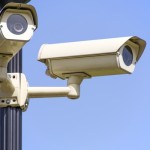Security Cameras: Analog Versus IP
Whether you are looking to upgrade your analog security cameras, or you are shopping for a new security system, it’s important to know the differences between analog and IP cameras to determine which type will best suit your needs. There are advantages and disadvantages to both types of cameras – be sure to review these before making a final decision.
Advantages of Analog Cameras
- Cost: If you have an existing analog system, it is obviously cheaper to stick with it. If you are on the market for security system, analog cameras are often significantly cheaper, and if you need to add more cameras, analog is likely the more cost-effective option.
- Availability: You will have an easier time finding vendors and installers for analog system since they have been around for years and are fairly simple to install.
- Simplicity: Speaking of, analog cameras offer an ease of use that make them very user friendly. The cameras send recordings to a DVR (digital video recorder), which then converts the analog to digital and stores it. And managing and using DVRs is simple as well.
- Technology: The technology used with analog has greatly improved over the years. High definition (HD) analog offers improved picture quality and resolution.
Disadvantages Of Analog Cameras
- Frame Rate & Image Quality: Analog cameras have a lower frame rate than IP cameras, so if you’re monitoring an area with lots of motion or need extreme detail, they are not ideal. Analog images are not as sharp and may appear grainy or blurry, and you cannot digitally zoom as you can with IP cameras. However, depending on the type of surveillance you need in a given area, high frame rate may not be a crucial factor.
- Less Coverage: Covering a certain amount of area may require more analog cameras than it would with IP cameras.
- More Cables: Analog cameras require a power cable and a DVR cable, whereas IP cameras only require one cable.
- No Encryption: The lack of encryption leaves you at risk for a hacker to potentially access your information or replace your signal with an outside one.
Advantages of IP Cameras
- Multiple Sensors: IP cameras can cover a larger area because they can contain as many as three to four cameras in one. All of these become one signal and are transferred through one cable to your system.
- Cost: Early on, the price difference between analog and IP cameras were drastic. Luckily, the prices have gone down and many IP cameras boast cost-effective prices. Also, because fewer IP cameras are required to the do same job as multiple analog cameras, your investment can be more beneficial.
- Installation: IP cameras only require one cable per camera and allow you to focus and zoom remotely. So long as your camera is installed at the right angle, you can easily control and manage your video feed from your workstation.
- Resolution: IP cameras have better image quality than analog cameras, and are available with different resolutions and aspect ratios to suit your needs.
- Intelligence & Analytics: IP cameras offer the ability to compress and store videos as well as provide a variety of different analytics. Some types of analytics you can program include motion or smoke detection, people counting, color tracking, and more.
- Security: IP video is encrypted and authenticated to ensure secure transmission.
- Equipment: IP camera systems require less equipment (analog requires more cables as well as an encoder and decoder).
- Open Platform: IP cameras are essentially universal and make it easy to add new features and functions to your system.
Disadvantages Of IP Cameras
- Cost Of Initial Set-Up: Upfront pricing may be more initially, but it can pay off in the long run. Once set up, it is must easier to tailor and scale your system as needed in the future.
- Storage: Since IP cameras produce higher resolution images, they generate larger files which require more storage space.
- Learning Curve: There is a user interface that end users may need to get accustomed to. While it is mostly intuitive, there is a certain level of technicality that needs to be learned.
From Analog To IP
If you are making the switch from analog to IP, here are some helpful tips.
- Bring in an independent consultant. You may have unrealistic expectations for your cameras that do not fit their capabilities, and an impartial party can help you see that.
- Replace as you can. If budget is not an issue, switching out your entire analog system for IP cameras at once is feasible. However, many of us have limited budgets, so replacing a few cameras at a time may be more practical. In doing so, you are creating a hybrid system, which supports both analog and IP cameras. Start by replacing the most important cameras to IP and create a plan for switching the rest of the analog cameras as they run their course.
- Find an installer/vendor that specializes in IP systems. It is beneficial to work with someone who understands the technology and networking of the system and is capable of installing your system properly and advising you on how to use it.
- Discuss what you really need. Just because IP cameras provide a wide range of capabilities does not mean you necessarily need all of them. Determine what you want your cameras to accomplish, what you really need, and how your budget can help you carry out your vision.
- Revisit your security plan. When making the switch, it is the ideal time for you to revise your security plans and reevaluate your approach.
What other transition tips can you think of? Share with us on Facebook, Twitter, LinkedIn, and Pinterest.
If you need help choosing IP security cameras, or would like to request a site survey or free quote, please call us at 888-203-6294. You can also browse our stock of quality security cameras online at SecurityCamExpert.com.
Upgrading Security Camera Systems
It’s about time to upgrade your analog cameras to HD-CVI or IP security cameras. By upgrading, you are equipping your home or business with more advanced surveillance solutions. These advanced cameras deliver top quality, with 720p or 1.3 Megapixel and up to 4K resolution. Worried about the compatibility with your current system and the new cameras? Luckily, there are products out there to aid in a smooth transition. And if you have any questions, you can always call SecurityCamExpert.com at 888-203-6294.
Here are some tips to help you ease into a better quality surveillance camera system.
Storage
If you are only upgrading a few cameras, hybrid and tribrid DVRs allow you to use new HD cameras with your existing equipment. However, higher resolution cameras will use more disk space.
If you want to maximize your storage space, you may want to consider is decreasing the frames per second at which you are currently recording. For example, if you are recording at 30 frames per second, you may scale that back to 15 frames per second. You will save storage space while still producing quality images.
In addition, if you are currently recording around the clock, you may want to switch it to motion-only. This setting allows your camera to remain in standby mode and only record when motion is detected.
Wireless Bridge
A wireless bridge is used when you want to install a camera in an area where it is impossible to run cables. It can be set up as a transmitter or a receiver. Each camera needs one transmitter, but the receiver can receive signals from multiple transmitters.
But remember, this will only work with network or IP cameras. And for most cameras, you will still need a power source.
Baluns
You may be hesitant to upgrade because wiring your system can be a costly hassle, however, baluns could be the easy and convenient answer.
Your existing cables depend on the type of security camera system you have. Most IP camera systems use CAT5 or CAT6, while traditional analog systems and HD-CVI systems run on cables more commonly known as Siamese cable (which is coaxial cable along with and 18/2 power wire).
A balun is a type of converter that you put on each end of your existing cable. Depending on the type, it will either allow you to convert CAT5 to an analog signal or use your analog cables with IP cameras.
DDNS (Dynamic Domain Name Service)
For remote access and viewing of your surveillance footage, you need to connect your system to your home or business IP address. Unfortunately, these are usually provided by your internet service provider (ISP) and they will often change this IP address, making it difficult for you to connect to your system.
The DDNS is a personal domain name (ex. “YourLastName.DDNS-service.com”) which will always resolve back to your home IP address regardless of what the IP address is, even after it has changed. Thankfully, a DDNS configuration is built-in most new security recorders, so when your home IP address changes it will contact the DDNS service and update it so that your domain name will always resolve back to your home or business.
If you need helping choosing a new security camera system for your home or business, please feel free to contact us! You can browse our stock online or give us a call to speak with one of our representatives directly. You may also connect with us on Facebook, Twitter, LinkedIn, and Pinterest. Your security is our priority and we are always happy to help.
Transitioning From Analog Security Cameras To IP Surveillance
Upgrading your analog security cameras to IP security cameras has plenty of benefits, including improved image quality and advanced features. Most IP surveillance systems can make use of existing network infrastructure that is in good condition, decreasing costs for installation. Whether you are looking to upgrade because your analog system is reaching end-of-life for support or because your needs have changed, an IP surveillance system is a smart decision.
Now, the actual task of transitioning from analog to IP security cameras should not be taken lightly. You want to be sure that you take all things into consideration to ensure that you choose the right IP video surveillance system and that it performs sufficiently. Here are a few aspects you should not overlook:
Goals & Challenges
If you are looking to achieve ROI, you must fully understand how your IP security system will be used. Operational goals and potential challenges should be determined beforehand. Think about what types of cameras and how much resolution you need, as well as how long the footage needs to be stored and which areas need coverage. Proper planning is crucial to the success of your security system.
Budgets
No one wants to pay an arm and a leg for a mediocre surveillance system. If done correctly, you don’t need to. By defining a security budget, you can find the right cameras and video management software (VMS) to fulfill your needs and achieve your goals.
Time
As much as a quick transition sounds ideal, it is not always feasible. Understand that a proper transition will take some time, and it may be in your best interest to plan a phased migration. This will help to accommodate budget availability and operational disruptions. Prioritize which area needs immediate attention and begin there.
Storage
Going from analog to IP improves video quality, but also requires more storage. Advanced VMS can help to effectively optimize your network resources and bandwidth consumption, thus decreasing networking and storage costs over time.
Staffing
A new IP video system may need additional staffing, so you should think about this and how you will train the new and existing staff. This will impact both overall costs and ROI of your system, and may affect cameras and software selection. For example, casinos require live monitoring around the clock while parking lot surveillance may use video analytics to alert security personnel of incidents or events that need attention.
Integration
Numerous third-party integrations can help to increase the efficiency of your system as well as manage costs. While most current systems have an IP-based interface for integration, leading suppliers also have a wide range of integrations which are tested and ready to apply. These can offer functionality, automation, and other enhancements to solve project needs.
Cybersecurity
Cybersecurity is of utmost importance, especially these days. If not addressed properly, going from analog to IP opens up your system, and any indirectly connected networks, to endless vulnerabilities. Be sure to discuss your specific network safeguards, policies, and strategies with your installer. Also, enlist a new IP security system that provides the appropriate cybersecurity architecture, software, devices, and policies.
Licensing
Pay attention to licensing requirements and Software Upgrade Plans (SUPs) or Service Level Agreements (SLAs) that come with most VMS systems. These cover everything from higher tiers of support to future upgrades. For example, third-party cameras may require a license for each IP address, and these licensing requirements can add additional costs.
Environmental Conditions
These include extreme heat or cold, humidity, corrosion, and high dust levels, along with ambient light levels, existing power sources, and network infrastructure. All of these can impact which security cameras and VMS equipment are necessary for you.
Redundancy
Because your security system should be operational and accessible at all times, it is important plan provisions for redundancy and back up for primary resources in case they fail. For most systems, simple RAID-5 or -6 redundancy in storage is sufficient. However, you should also consider budgeting for “failover” recorders and other server hardware, and have spare cameras on hand in case of failure.
It is only a matter of time until IP surveillance is the norm and analog security cameras are a thing of the past. But when the day comes, it is ever important to understand your security needs and what you expect from your IP surveillance system. Even a small mistake or misstep along the way can compromise your system.
Have you upgraded to an IP security camera system? Share your stories with us on Facebook, Google+, Twitter, LinkedIn and Pinterest. You can shop our selection online at SecurityCamExpert.com or call 888-203-6294 to inquire about our products, installation services, or request a free quote!
Why You Should Invest In Business Surveillance Systems
As the New Year approaches, you may resolve to invest in a better business security camera system. Increasing your security measures can provide numerous benefits and will likely pay off in the long run. Here are a few ways a security system can help improve your business.
- Increase Customer And Business Safety
The presence of security cameras not only helps to deter burglars from targeting your business, but it can also bring peace of mind to your customers and employees.
- Reduce False Claims
There have been instances where employees fake an injury to claim worker’s comp, as well as customers who may make false claims against the business or employees. Security cameras can prevent these instances or provide evidence to refute these claims.
- Minimize Employee Theft
Security cameras and surveillance can positively influence behavior, resulting in employees complying with company policies.
- Avoid Loitering Around Premises
You not only want to secure the inside of your business, but protecting the perimeter is just as important. Loitering may send the wrong message to your customers, and may negatively affect your business.
- Prevent Site Littering
Aside from loitering, litter scattered around your business can damage the business reputation. You want to maintain an appealing look for your customers, and excessive litter can be detrimental.
- Replace Full-Time Security Guards
Rather than having a security guard on the grounds, you can actively monitor your premises from within or remotely.
- Track Business Traffic
Keeping track of your business traffic can improve your business success. You can identify the busiest hours and adjust your staffing accordingly. It may also give you insight to the most efficient business hours for your location.
- Tie multiple locations into one surveillance system.
If you have more than one location to monitor, an advanced security system will allow you to connect the different security systems. That way, you may be able to remotely monitor all sites from one app or system.
If you need help finding the right security camera system for your business, feel free to visit us online at SecurityCamExpert.com or call 888-203-6294 to speak with a representative. You can also connect with us on Facebook, Google+, Twitter, LinkedIn, and Pinterest.



